The winners of the 2023 Ocean Art Underwater Photo Contest have been revealed. This year's overall winner, titled 'Aquatic Primate', was captured by Suliman Alatiq and shows a crab-eating macaque swimming through the ocean.
Suliman's stunning shot was taken during fieldwork in Thailand. View the diving macaque photograph, along with a few more of our favourites.
Ocean Art Underwater Photo Contest 2023 winners
Pygmy Poser | Byron Conroy – Marco (2nd place)

"I have photographed pygmy sea horses for many years, there are a few challenges to shooting them, first the eye contact. To have a relaxed specimen making double eye contact with the camera is very rare, secondly the polyps of the coral are usually closed. In order to get the polyps out I had to be the first person on this sea fan in the morning, I already knew this was a playful specimen from the day before so requested to dive the site at dawn when the polyps were out. And this guy is also pregnant and about to burst, so this trifecta of eye contact, polyps out and pregnant male made it the shot I have been after for many years. There was minimal editing, a little contrast, a slight rotation and very minimal crop were all that was needed, the subject speaks for itself." Byron Conroy
Location: Lembeh Strait, Indonesia
- Close-up Photographer of the Year winners 2023
- Comedy Wildlife Photography Awards 2023 winners revealed
- Environmental Photographer of the Year 2023 winners
The Beauty of the Swamp | Bryant Turffs – Compact Wide Angle (1st place)
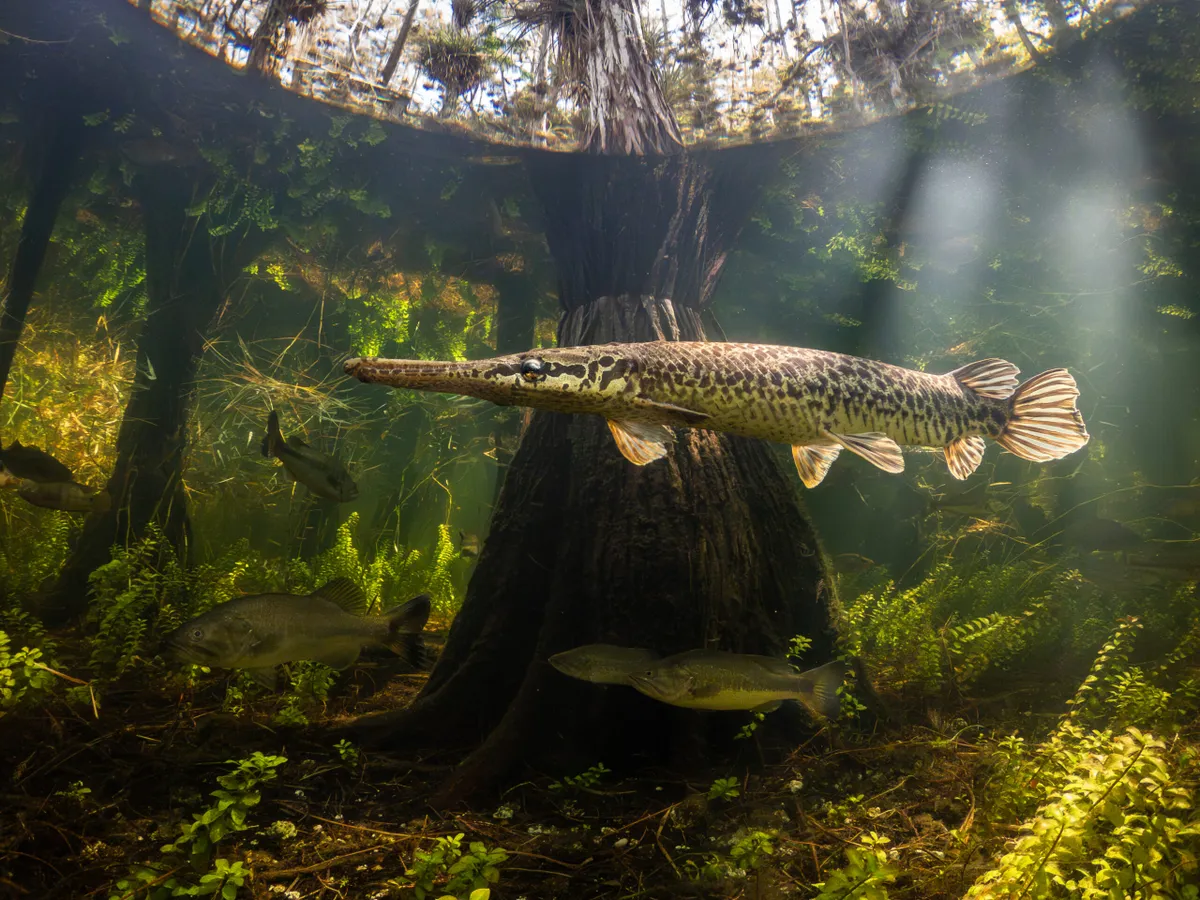
"Exploring new environments, especially seldom visited ones, is one of the greatest pleasures of underwater photography for me. The Everglades is a rightfully foreboding environment, but also one of great beauty and interest. To capture this image, I was careful about avoiding risks, like alligators, in the area that I was snorkeling. Shooting with my GoPro made getting the camera close to my subjects easy. In this frame, I sought to capture a beautiful, native, Florida Gar against the backdrop of a cypress dome with light rays filtering through the trees. As a fish nerd, observing the many beautiful species that call this environment home is another joy. This image also features native largemouth bass in the background. Although not featured here, many of my frames from this day of shooting also captured invasive fishes, illustrating just one of the many impacts human actions have had on this imperiled ecosystem." Bryant Turffs
Location: Everglades National Park, Florida, USA
Stay-at-home Mom | Derek Singer – Compact Behaviour (1st place)
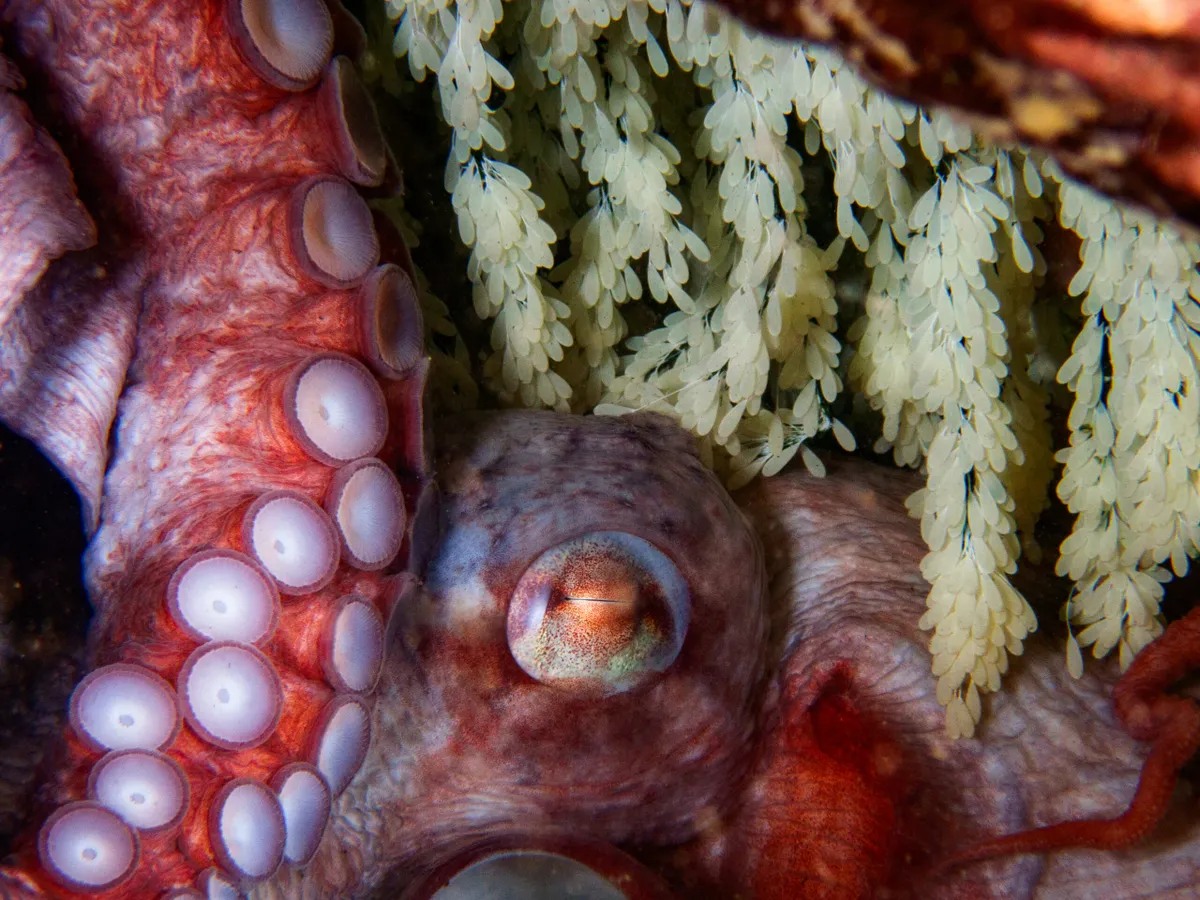
"While GPOs are a common sight here in the Pacific Northwest, seeing a female nesting is rare enough that when someone does find one, word of mouth spreads quickly. In this case, my dive group had heard a couple nests were found at Sund Rock, an excellent site for finding GPOs in general. Since their dens tend to be in crevices and cuts in the rocks, getting a well-lit and well-composed photo with a large full-frame camera can be difficult (and risky if you’re shooting with a dome). Although the female will spend months caring for her eggs, we can never predict when they'll hatch and she'll die. I was intent on making the most of my opportunity since it may have been my only one.
"Therefore, I decided to bring my TG-6 instead of my normal SLR. With the smaller form factor and very short minimum focusing distance, I was confident I could get the camera and the strobes close enough to capture a striking image. It turned out to be a good call because this particular nest was tightly ensconced in a pile of rocks. I captured a series of close-ups of the mama octopus circulating water through her eggs before getting distracted by another GPO wandering out in the open. This specific image best portrayed the tightness of the quarters and balanced the mama and her eggs. From the RAW file, my edits were focused primarily on boosting the contrast to make the colors and textures pop." Derek Singer
Location: Sund Rock, Hoodsport, Washington, USA
Bunk Buddies | Suliman Alatiqi – Wide-Angle Category (1st place)
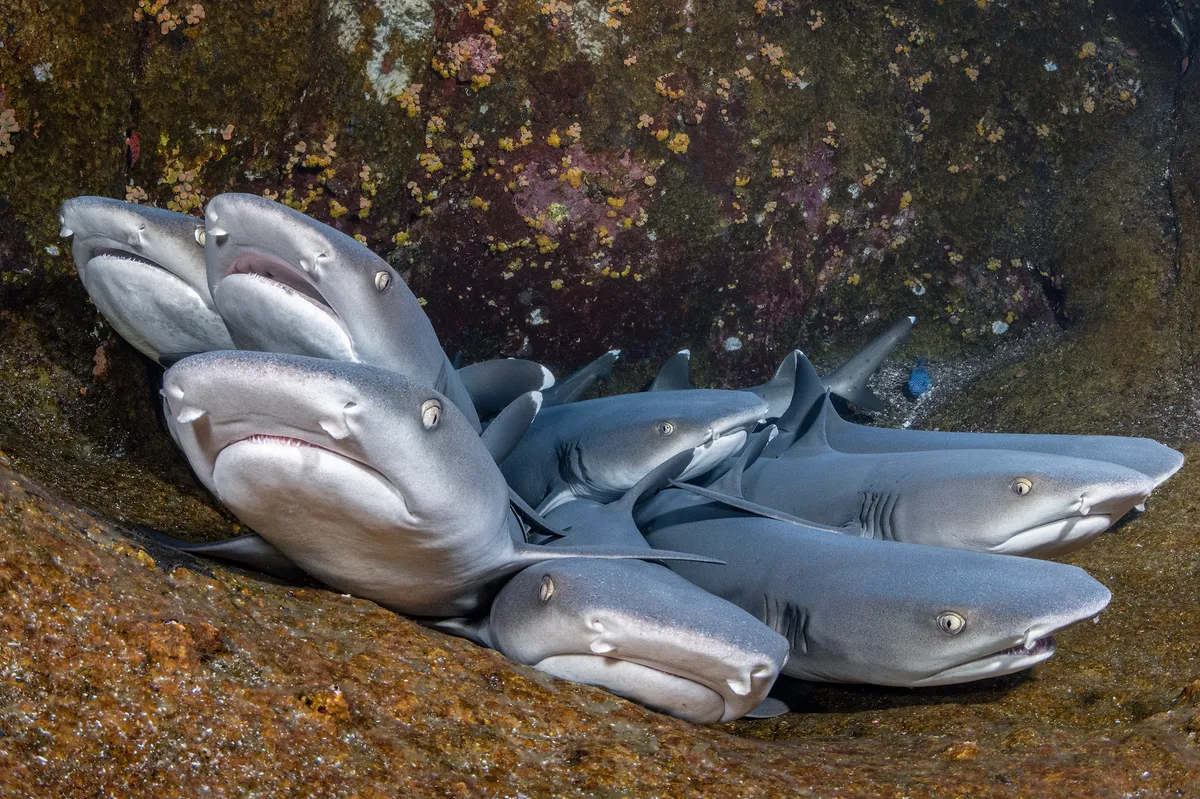
"Whitetip reef sharks are one of few shark species that rest in place. At Roca Partida, a small island, real estate is limited for the many whitetips that live there and they can often be seen bunking together. I wanted to get a photo of all of them facing me and with a lot of patience and a careful approach I managed to do so." Suliman Alatiqi
Location: Roca Partida, Mexico
Cavalluccio | Alberto Casati – Macro (1st place)
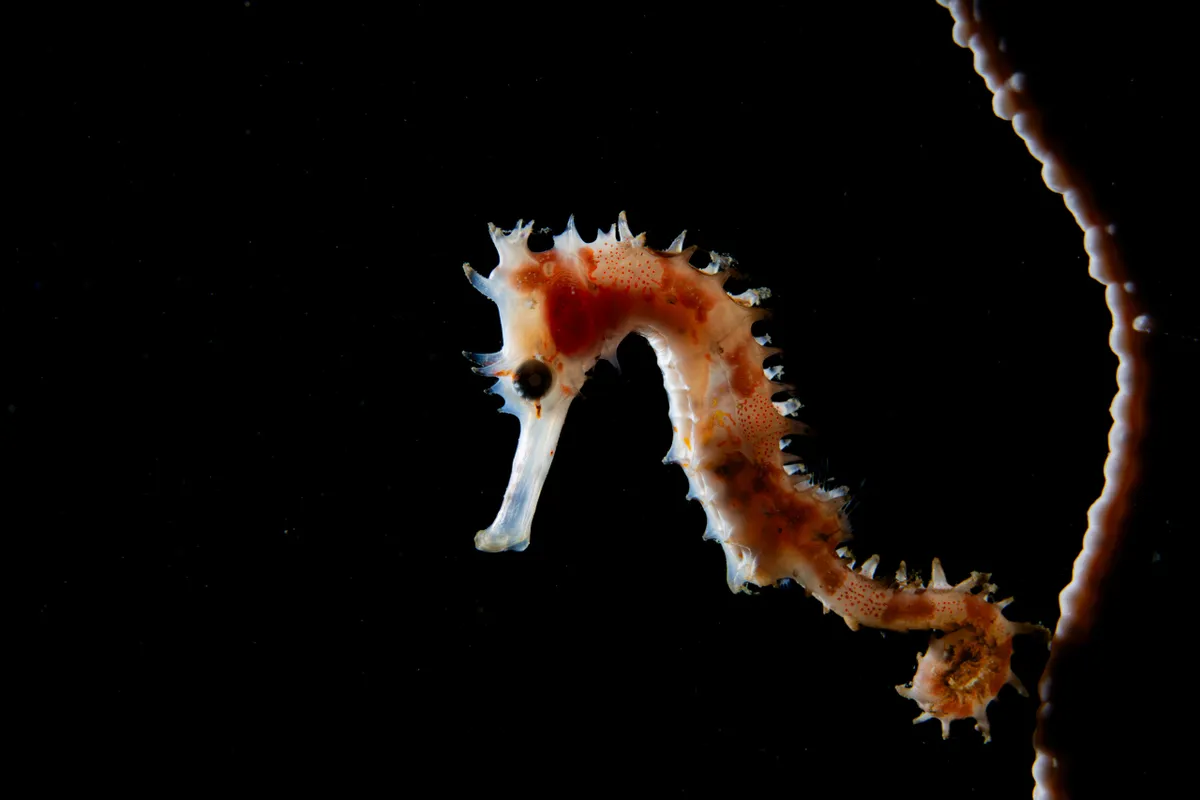
"During the dive, I saw this little subject and I decide to take the picture using a snoot with technical backlighting." Alberto Casati
Location: Puerto Galera, Mindoro, Philippines
The Birthday | Kenji Sato – Marine Life Behaviour (1st place)
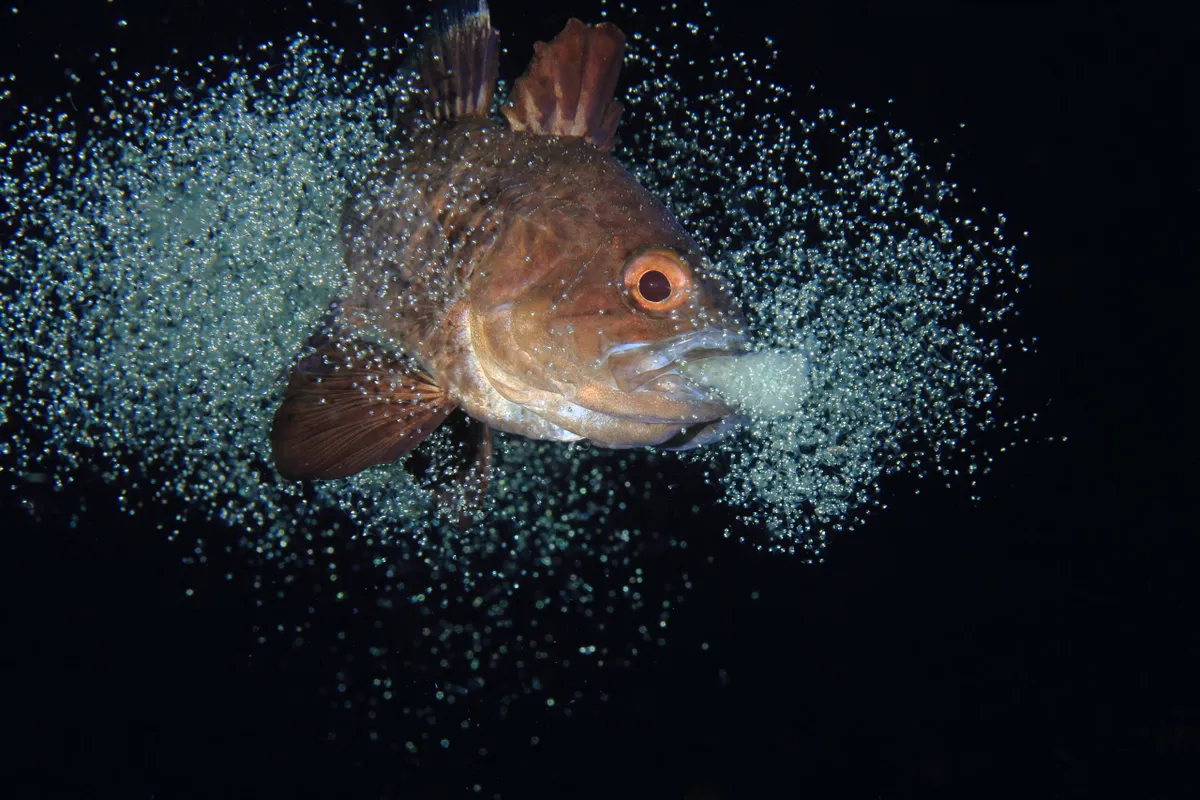
"Black cardinal fish live in shallow coastal waters, and males raise eggs they receive from females in their mouth (mouth brooder). The eggs hatch in about a week. Until they hatch, males stay still behind a rock and feed the eggs with fresh seawater. At first, I did not know when the eggs would hatch, but after a few observations, I could tell when the eggs would hatch. Hatching occurs within a few hours after sunset. At the moment of hatching, the father swims upward and spits out the babies in an instant. So, it's difficult to take a picture.
"It is said that the number of fries in a single hatching is about 20,000, so the moment of hatching is quite impressive. As soon as the babies hatched, they scattered all over the place. I hope that many of the fry will grow up and survive next year." Kenji Sato
Location: Miura Peninsula in Kanagawa Prefecture, Japan
Squid hunting | Keigo Kawamura – Blackwater (1st place)
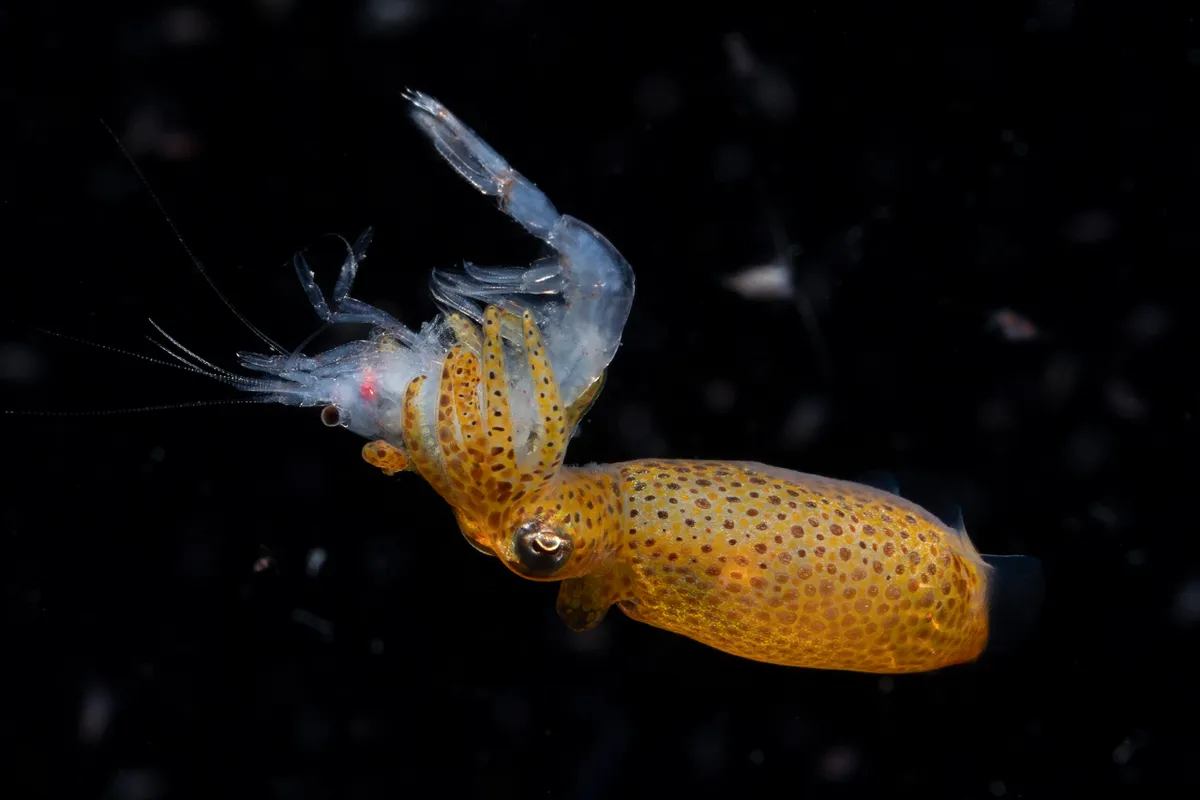
"I collect and photograph floating creatures at night, Bonfire style. Many squid and shrimp will gather in the underwater torch. The squid in the photo is known to be the smallest in the world, and the pygmy squid successfully preyed on a shrimp as large as its own body. Pygmy squid eat shrimp by inserting their mouths into the gaps between their shells." Keigo Kawamura
Location: Japan
Brainception | Dan Mele – Underwater Conservation (4th place)
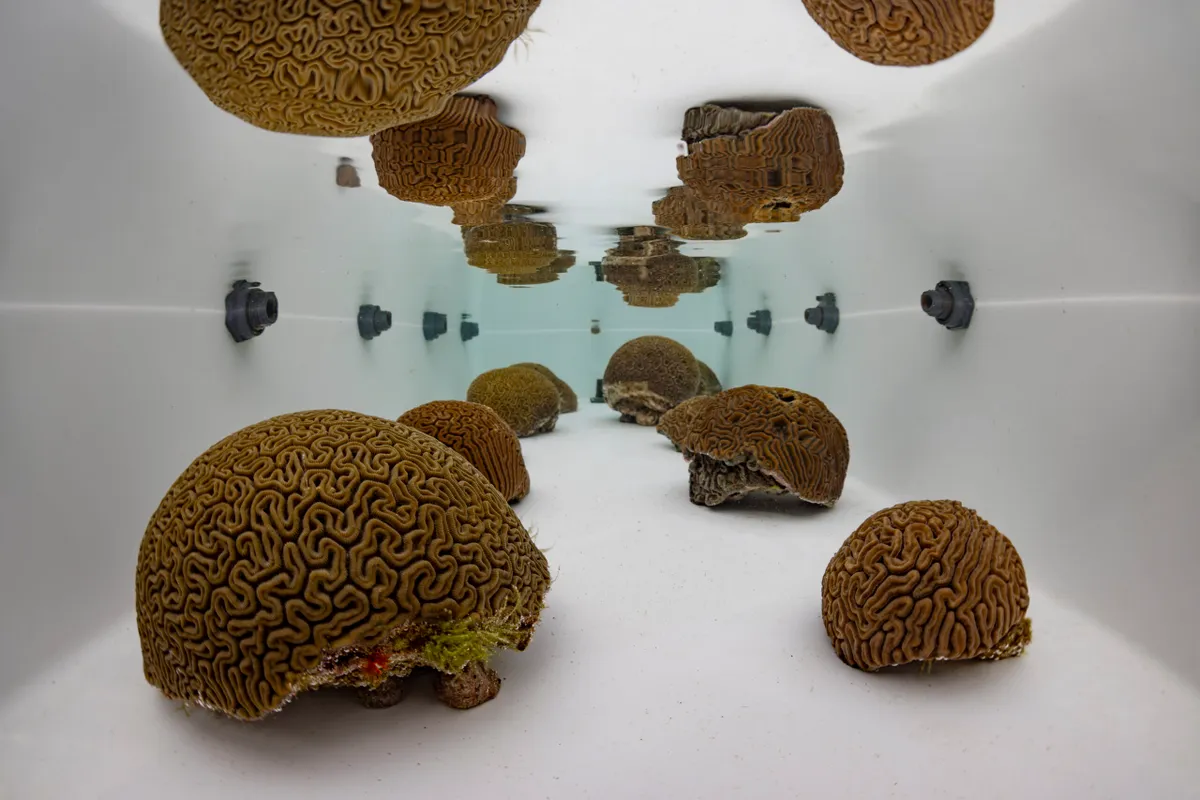
"Most corals spawn once a year in synchrony by using several environmental cues. Due to the ongoing degradation of coral reefs, many surviving corals of the same species are now spaced too far apart on a reef for successful fertilization to occur. At the University of the Virgin Islands, coral researchers temporarily removed several grooved brain corals from reefs surrounding the U.S. Virgin Islands and brought them into a land-based coral nursery, where they're spawned in controlled conditions. These techniques allow researchers to collect sperm and eggs from several corals efficiently and fertilize them in the lab, where they can be grown and eventually outplanted back to the reef. After spawning, the corals removed from the reef are placed back to the same reef which they were collected from.
"This technique of assisted fertilization is also sometimes called assisted evolution. The corals inside this table have survived several prior bleaching events, hurricanes, and disease outbreaks, such as the devastating Stony Coral Tissue Loss Disease. This means that these individuals may harbor essential genetics, making them more resilient to several environmental stressors that kill corals. By spawning and crossing these survivors, it's hoped that this may lead to more robust and resilient corals better equipped for the future environmental parameters of our oceans.
"Just before they're expected to spawn in the nursery, the water flow is turned off, bringing a calmness to their environment and creating the perfect opportunity to shoot the reflection of the corals in the still water surface. With the corals-filled nursery, I only had a few locations to slip my camera in. Fortunately, this vantage point gave me lots of depth to work within the nursery." Dan Mele
Location: University of the Virgin Islands, U.S. Virgin Islands
Afternoon Acrobatics | Jon Anderson – Black & White (2nd place)
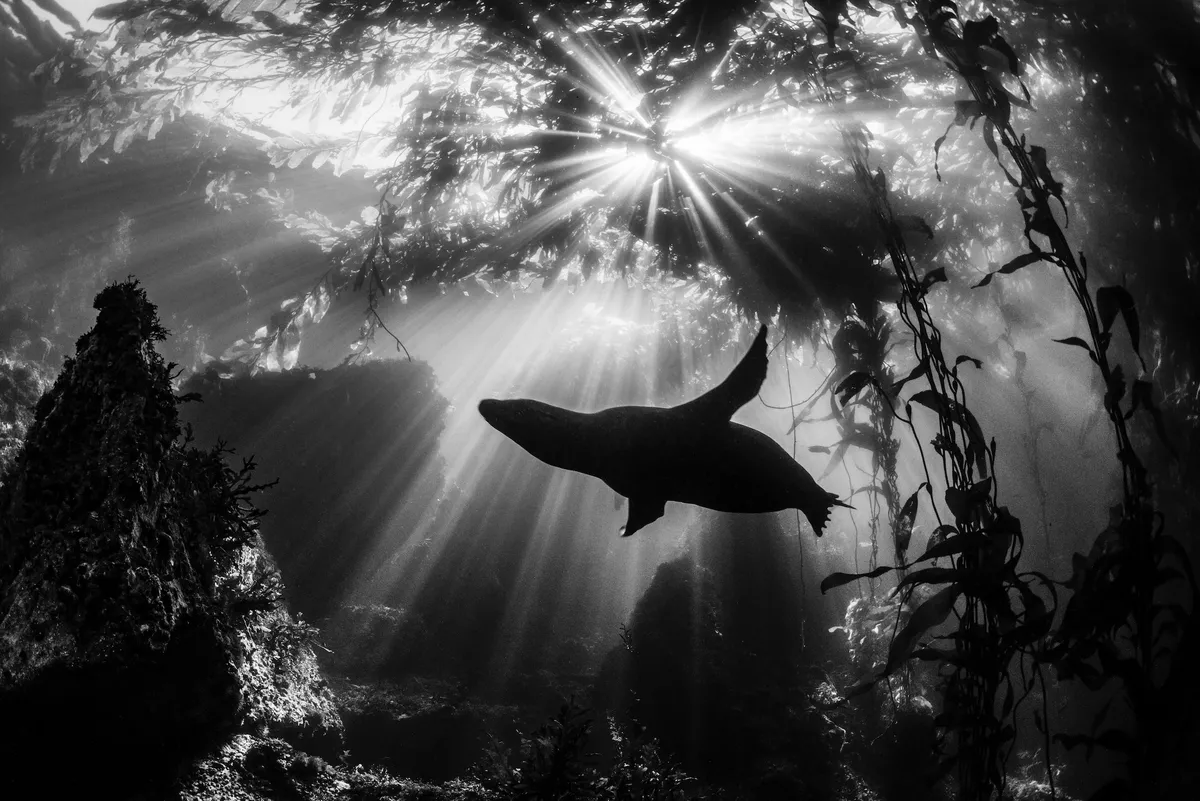
"Summer’s rich bounty of sardines, squid, and anchovies bring an increased concentration in the number of California sea lions in the Monterey Bay. They haul out along jetties, harbors, and rocky areas throughout the bay between their fishing expeditions. Hundreds of sea lions congregate on and around the breakwater at the Monterey harbor which also happens to be one of the most visited dive sites in Monterey. It’s nearly impossible to dive here and not catch at least a glimpse of a sea lion out of the corner of your eye. I noticed a pattern of sea lions swimming parallel to the wall, navigating through the kelp forest to return to the end of the breakwater where they haul out and socialize. Imagining this photograph in my head, I determined I would need a bright sunny afternoon for the light to be right and patience to wait for a sea lion to swim through the kelp forest scene I had selected." Jon Anderson
Location: San Carlos Beach, Monterey, California, USA
After the Wedding | Peter Pogany – Nudibranchs (1st place)
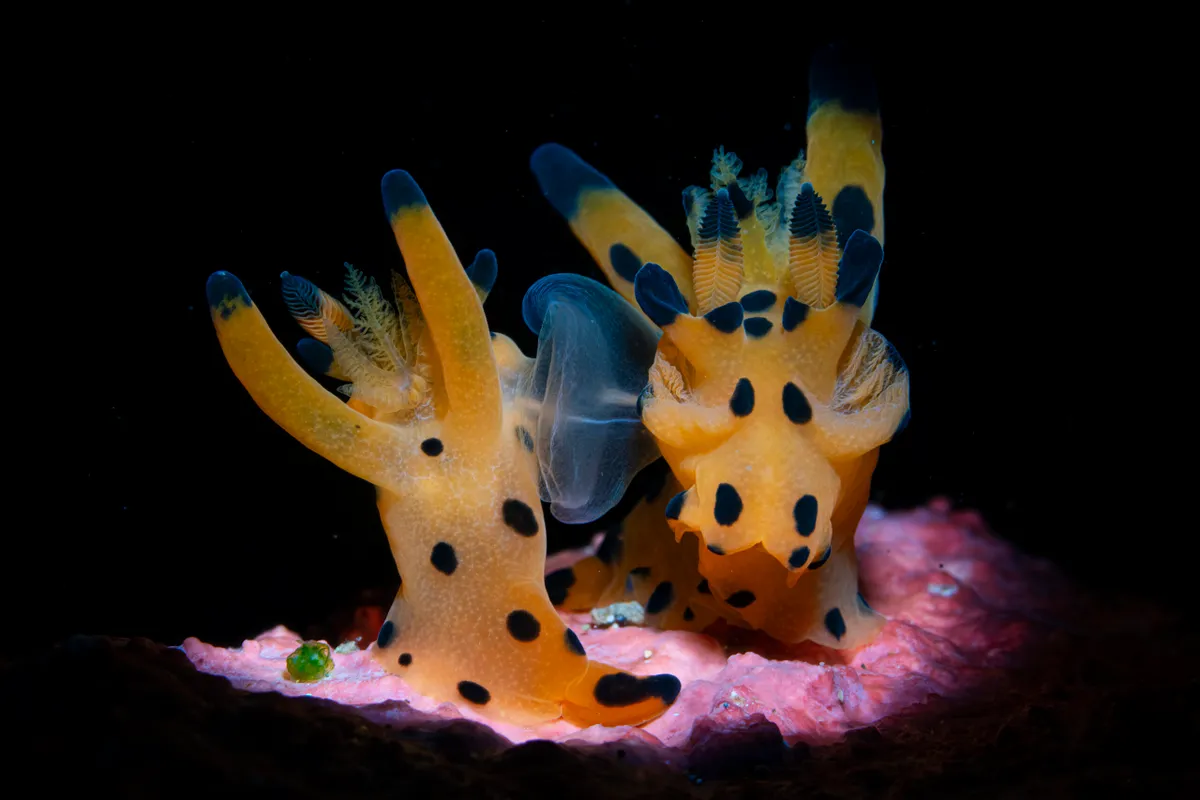
"In the past two years I dove in Anilao on three separate occasions. We encountered this species on our first tour and were delighted to find that they were mating. My two diving buddies busied themselves with the nudibranchs, and by the time it was my turn I had no air left. I hardly hoped to get a second chance to observe this special event. But on our third tour I caught them 'in flagranti'." Peter Pogany
Location: Anilao, Batangas, Philippines
Snowy Night | Jialing Cai – Nudibranchs (3rd place)

"I captured this image during a blackwater dive a few days after the Taal Volcano eruption in the Philippines in early 2020. This female paper nautilus was hitchhiking on a floating piece of wood debris in the extremely turbid water. It belongs to the octopus genus called Argonauta, one of the few octopi’s lineages that live in the open ocean. The females are unique in having evolved a shell for laying eggs. As I pressed the shutter, the surrounding particles reflected my flashlight in a manner that created the illusion of falling snow. For blackwater photography, we like to place the strobes in an angle and position where the light can shine directly on the subject, ensuring a clean dark background. However, when I initially attempted to capture this Argonaut, I was unaware that the strobes were placed in a “wrong” position. The light was shining on the space between the subject and my camera, which had illuminated the presence of all the surrounding particles. Instead of portraying chaos in the aftermath a natural disaster, these particles evoked an unusual sense of serenity, transforming the scene into a fairytale set on a snowy night.
Blackwater photographers are obsessed with clear water. We are drawn to the pure darkness that mirrors the vacuum of outer space. We tend to forget that the suspended particles which include the sand grains, organic matter and even miniscule organisms are an integral part of the ecosystem. These particles always fade into the background or are simply removed through editing, but they form the foundation of the complex marine food web. If the water were genuinely transparent, there’s no way the ocean could sustain such abundance of life. The “snowflakes” in this captured scene always remind me of these tiny yet ubiquitous existences." Jialing Cai
Location: Anilao, Batangas, Philippines
Into the Flames | Miguel Ramirez – Compact Macro (Honourable Mention)

"During a night dive on Reunion Island, I saw a huge Spanish dancer. And when I looked closer, I noticed that there was an emperor shrimp hidden in its gills! I was happy because it's the first time I've seen this association on a dive on Reunion Island (rarer to see it than in Indonesia!). I tried to put my camera at gill level to get the black background. The shrimp was just above her head, giving the impression that she was in the middle of flames!" Miguel Ramirez
Location: Reunion Island
Carp Love | Ferenc Lorincz – Cold Water (Honorable Mention)
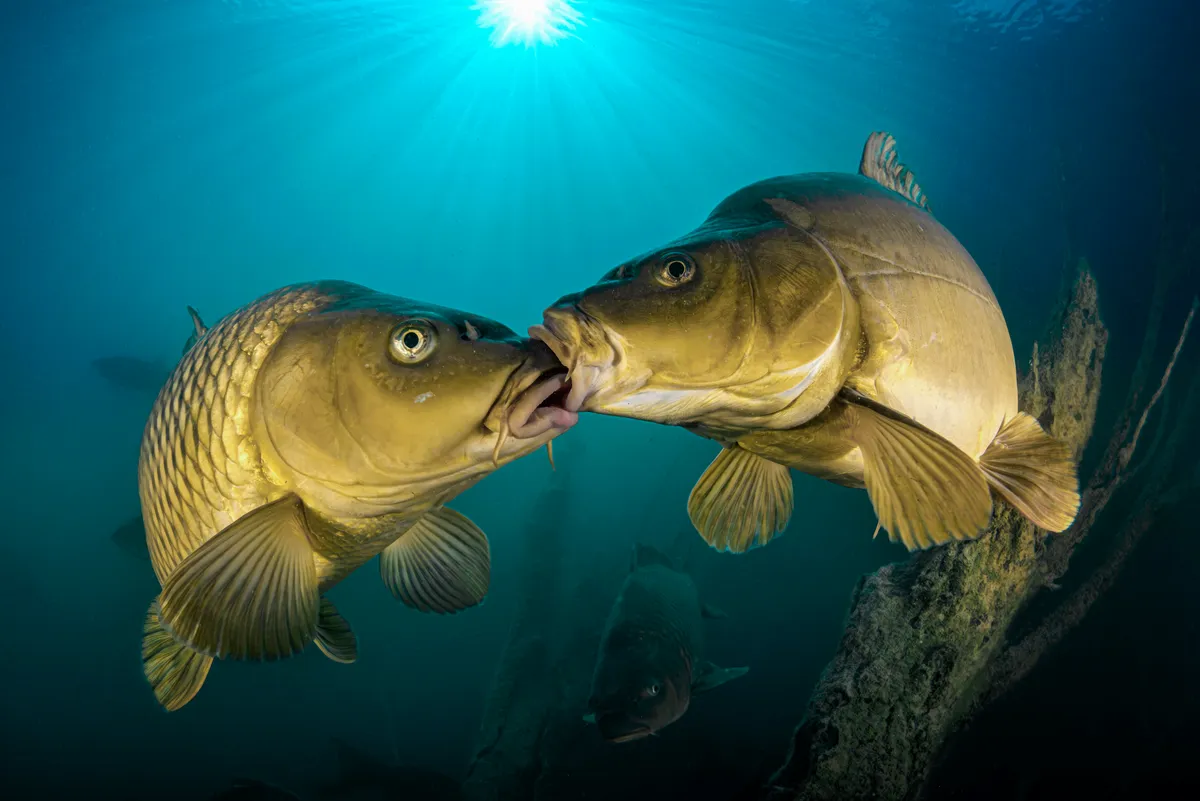
Location: Čierna Voda, Slovakia
Aquatic Primate | Suliman Alatiq – Portrait (1st place) and Best of Show
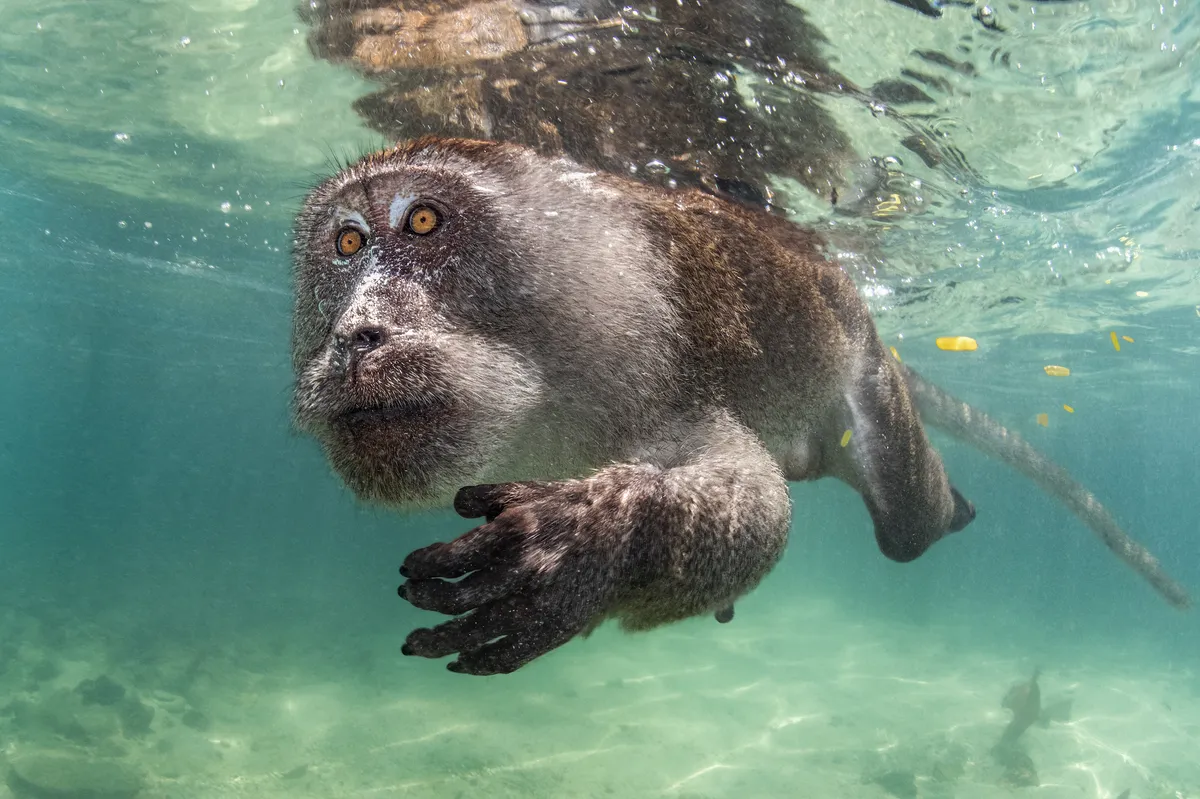
"During fieldwork at Phi Phi Islands, Thailand, spanning several weeks, I focused my efforts on documenting the maritime behavior of the Crab-eating macaque with particular focus on their water forages. The macaques have adapted very well to living around the sea and will venture into the water for various reasons including transportation, scavenging, cooling down and playing. Highly efficient swimmers, they can dive for up to half a minute and can cover short distances faster than most humans. This photo offers a rare glimpse of the swimming movement of a male macaque." Suliman Alatiqi
Location: Phi Phi Islands, Thailand